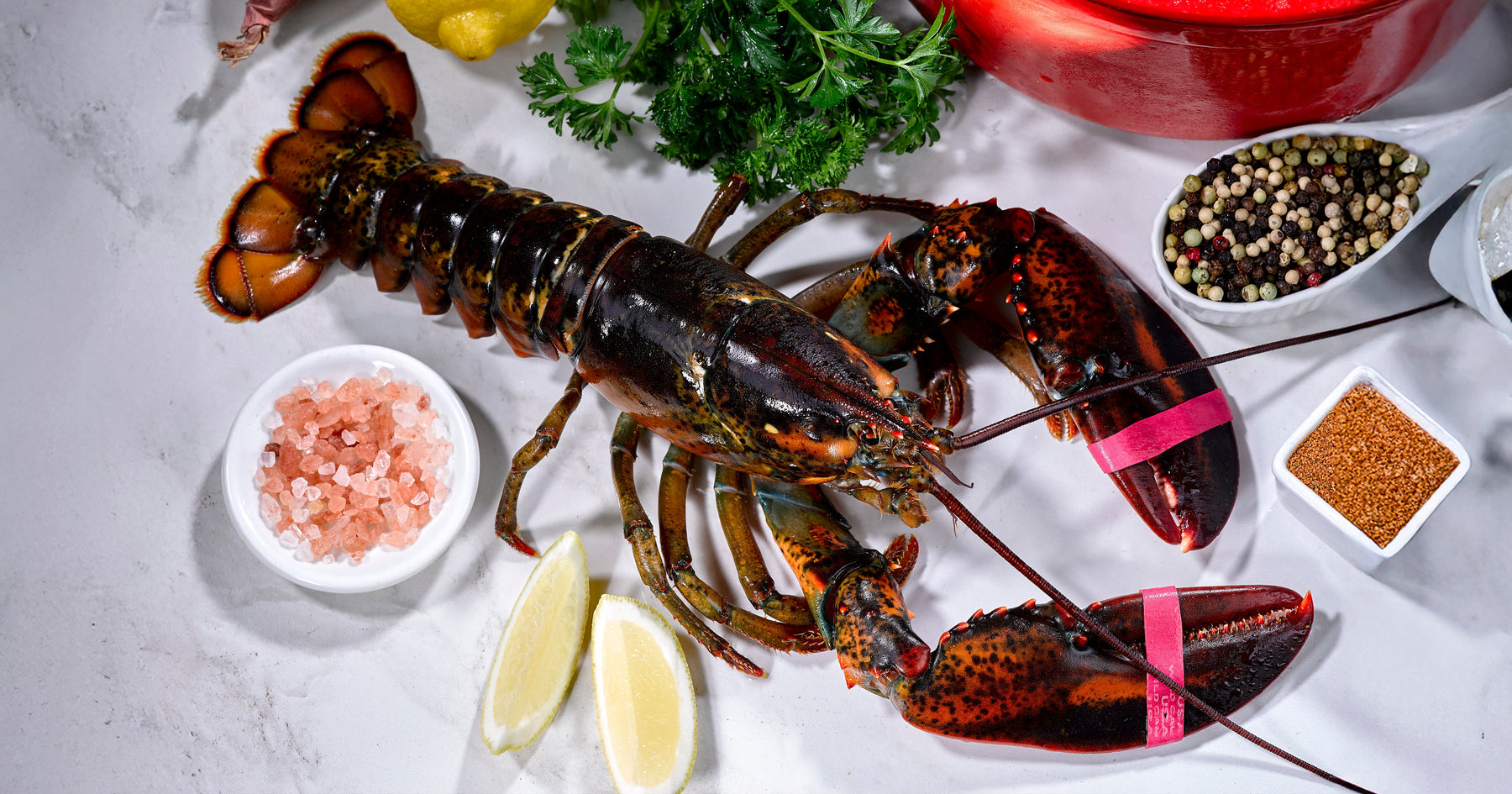Edible Parts of a Lobster

Is there anything sweeter than the anticipation of cracking open a freshly cooked lobster, besides the lobster meat itself? Lobsters’ mouth-watering claw and tail meat capture the hearts and stomachs of millions of eaters every year for generations. Most people who’ve experienced a lobster meal from a restaurant, backyard barbecue, or seafood boil know what luxury awaits inside an American lobster’s vibrant red shells. But what are the best chefs hiding in their dishes that make lobster go from great to incredible? The magic of a lobster extends throughout most of its body, far beyond just tail and claw meat.
If you want to extract every bit of flavor from a lobster or if lobster claw or tail meat wasn’t enough to satisfy your cravings, this guide is for you. We've teamed up with our culinary curator, Katie Lee Biegel, to teach you how to eat lobster like a chef, enjoying every edible part of the lobster, and which parts of a lobster you should not eat. From hidden pockets of succulent meat to lobster broth ingredients in plain sight, you'll learn how to eat lobster while honoring every bit for sustainable “whole animal” cooking and maximal enjoyment.

What Are the Edible Parts of a Lobster?
It’s common knowledge that lobsters have remarkable meat inside. What’s lesser known, however, is that lobster meat makes up around to 20-30% of its total weight!
"Many people only go for the tail and claws,” explains Katie. “Discovering how much flavor is hidden in the rest of the lobster will change how you eat and cook it”.
Enjoying these edible lobster parts below, from most obvious to most overlooked, can help you use nearly 100% of the lobster in your kitchen.
- Tail Meat: The lobster tail hails as the quintessential prize—firm, sweet, and delicately briny with a texture that's both tender and snappy. Lobster tail meat offers a clean ocean flavor that's neither fishy nor overwhelming, making it perfect for grilling with a brush of garlic butter or incorporating into elegant dishes like lobster thermidor. The tail's substantial size and consistent texture make it ideal for both novice and experienced seafood lovers to cook and enjoy. It holds up to strong flavors, like in our Panang Curry recipe. To eat a lobster tail, simply remove the meat by cutting down the middle or sides of the bottom of the tail with a knife or kitchen shears, and bend the shell away to expose the meat. You can then eat the cooked tail meat on its own or with a sauce.
- Claw Meat: Lobster claw meat is unquestionably a crowd favorite. Claw meat offers a slightly different experience from tail meat—often sweeter with a delicate flakiness that gives a melt-in-your-mouth experience, perfect for lobster rolls. The meat from the lobster’s crusher claw tends to be firmer, while the ripper claw yields more delicate strands. Cracking open lobster claws requires a bit of technique, but the reward is worth the effort. Use a nutcracker or lobster cracker to break the shell, then carefully extract the meat with a small fork or pick.
- Knuckle Meat: Located between the claws and the body, lobster knuckle meat is coveted by true connoisseurs because it offers some of the sweetest, most tender gems on the entire lobster. These small cylindrical sections contain surprisingly substantial amounts of meat for their modest size. To try this hidden treasure, gently twist the knuckle sections away from the rest of the lobster and crack them open like you would a claw. Use a thin pick to extract every bite.
- Leg Meat: All ten legs on a lobster, beyond those famous front legs with pincers, contain edible meat. Although the back eight legs don't receive the same attention as the front two, a considerable amount of meat is available if you have the patience to shuck them. This meat is more delicate and less substantial than claw meat, but it offers a sweet, concentrated lobster flavor that's absolutely worth the extra effort. The easiest method of eating lobster legs is using kitchen shears to cut along the leg's length, then pushing the meat out with a skewer or thin utensil, like a lobster fork.
-
Lobster Shells: While you can't eat lobster the shell itself, these pieces are packed with incredible flavor that transforms soups, stocks, and sauces that give the best lobster dishes their “lobster essence.” For decades, lobster shell broth has been a secret weapon in professional kitchens, making a complex base that elevates classic dishes like butter-poached lobster or lobster bisque. According to Katie, “A great way to make the most of your lobster is to use the shells for rich stocks. It’s easy to do and the results are well worth the effort."
To extract the most flavor from lobster shells, roast them first, then simmer them with aromatic herbs and vegetables for one hour to create a deeply flavorful stock that captures the essence of the sea. Remember to always strain out all shell pieces before serving, as they're difficult to digest and pose a choking hazard. - Lobster Tomalley: The green stuff in a lobster is called “lobster tomalley,” or the hepatopancreas. Tomalley is a soft, green-gray substance that delivers an intensely rich, salty, and savory burst of flavor. It has a creamy, paste-like consistency and is often spread on crackers or incorporated into sauces for an extra depth of flavor. Tomalley is another favorite part of the lobster for many chefs and fishmongers alike! "Tomalley might not look like much,” Katie shares, “but it packs a serious punch of flavor. Mix a little into butter for dipping or fold it into a sauce for an extra layer of richness." Try it on your lobster avocado toast!
- Lobster Eggs (Roe): Are lobster eggs edible? Absolutely! Lobster eggs, known as lobster roe, cluster under the tail as small, dark red or black pearls. These tiny spheres offer a briny, oceanic flavor with a slight pop when bitten, similar to caviar but with a distinctly lobster-forward taste. Lobster roe’s firm texture is an excellent garnish for seafood dishes or can be enjoyed on its own as a luxurious treat. Many chefs prize lobster roe as a caviar substitute, incorporating it into pasta dishes, spreading it on blinis with crème fraîche, or as a garnish on dishes like Katie’s sheet pan fish tacos.
Parts of a Lobster Not to Eat
Although there's a culinary use for almost every part of a lobster, certain parts should be avoided. These inedible portions can affect both safety and flavor, so knowing what to skip is just as important as knowing what to savor. Katie adds, “These little bits are easy to identify and remove, and knowing this just ensures you have the best lobster eating experience."
- Intestinal Tract or Vein: The lobster’s intestinal tract, referred to as the vein, runs along the back of the lobster tail as a thin, dark line. While this "vein" isn't harmful to consume, it can impart a gritty, bitter taste that detracts from the sweet lobster meat. It's easily removed by making a shallow cut along the tail's back and gently pulling or rinsing it away.
- Stomach Sac: Located right behind the lobster's eyes, the stomach sac is a clear or slightly cloudy, balloon-like organ. This often contains shell fragments and sand, giving it an unpleasant, gritty texture and bitter flavor you certainly won't enjoy. It's easily identified and removed by hand during cleaning, so discard it for a better lobster eating experience.
- Gills: Lobsters' gills appear as elongated, feathery sacks above their walking legs, featuring a distinctly spongy, almost foam-like texture. Lobsters’ lungs filter water and can contain debris, bacteria, and other contaminants, making them both unappetizing and potentially unsafe to consume. They're easily identified by their unique texture and should always be discarded.
Where To Buy Whole Lobsters
Now that you know what parts of the lobster are edible and which to avoid, you're ready to approach your next whole lobster with the confidence of a seasoned fishmonger! We deliver live lobsters right from the docks to your door, making it easier than ever to try these American delicacies. To learn more about how to cook lobster, check out our blog on The Best Ways to Cook Whole Lobster.
